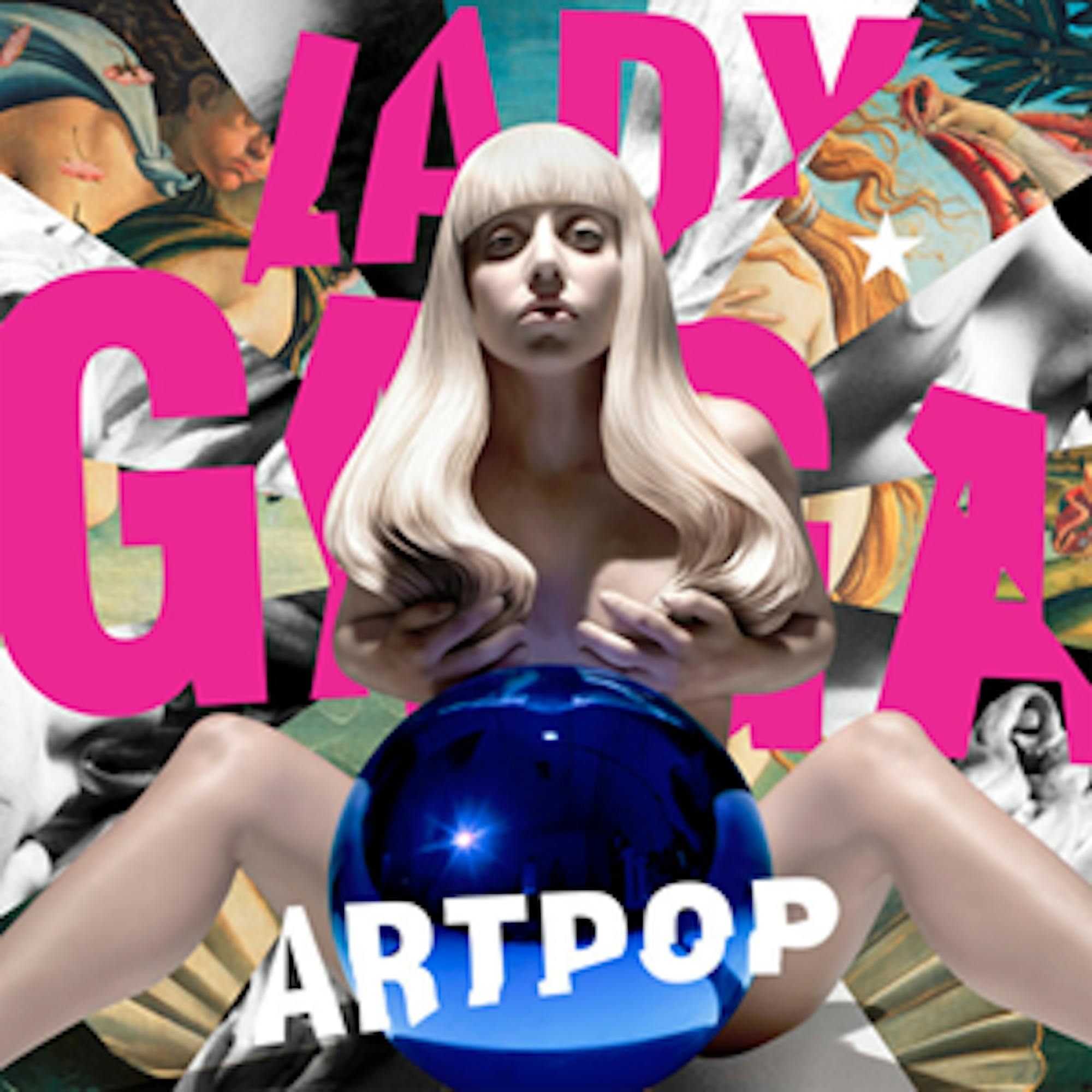Content warning: This article mentions trauma, eating disorders and sexual assault.
In the months leading up to its release, Lady Gaga called “ARTPOP” (2013) “a celebration and a poetic musical journey,” a reverse Warholian effort with the intention to “put art culture into pop music” and “fun, dirty dance music.” It’s a lot of paratextual information for her third studio album. Throughout its release schedule, “ARTPOP” was advertised through various television engagements, a short residency, “ArtRave: The Artpop Ball” tour (2014), an album release party in a warehouseand a controversial appearance at South by Southwest (more on that later). It was a massive undertaking that perhaps rendered “ARTPOP” one of pop music’s most promoted albums; an “ARTPOP” mobile app was even launched.
“ARTPOP” began a larger-than-life era for Lady Gaga, pop’s most outrageous and concept-focused musician. That context is important to consider when revisiting the album seven years later and questioning its status.
The album didn’t land well, especially when compared to the high standards set by Gaga’s previous endeavors, such as “The Fame” (2008), its reissue “The Fame Monster” (2009) and the monumental “Born This Way” (2011). Critics called “ARTPOP” “enjoyable but well-worn” and “sexual but not sexy.” Some songs were “half-finished,” and critics questioned why she was writing a third album about fame.“ARTPOP” didn't sell as well as Gaga’s previous releases and led to rumors that her label lost upward of $25 million on the project, though these claims were quickly recanted.
This lukewarm reaction pushed Gaga into depression and kept her away from dance music.It was only with her most recent release, “Chromatica” (2020), that the singer returned to the genre.
In 2013, Gaga was mostly a pop musician — she's always been versatile, but that wasn't what she was publicly known for — whose career could’ve been destroyed by one forgettable release. Thankfully, Gaga did some rebranding with the release of “Cheek to Cheek” (2014) and her performance of a “Sound of Music” (1965) medley at the 2015 Oscars. Her career was saved, but “ARTPOP” still needs to be questioned.
As fans celebrate the album on its anniversary, even after Gaga tweeted last year that she doesn’t remember the album, it’s important to consider the various revisionisms that question whether or not “ARTPOP” deserved its negative reception. Was the album just ahead of its time?
Our answer to this question first depends on how favorably we view experimentation in pop music. If we appreciate experimentation for its own sake, it’s easier to love “ARTPOP” for all its rowdiness. That’s not to say there’s no meaning behind the album; it is perhaps the most thematically rich album from Gaga who’s always exploring herself and how she sees the world.
But, if we expect clearer, more well-defined artistic meaning — something “ARTPOP” doesn’t necessarily have since it’s more of a conceptual collage — then we might be confused by Gaga’s extravagance. The Michelin Man-esque performance might feel like a stunt.Her Oval Office duet of "Do What U Want (feat. R. Kelly)" (2013) could come off as tasteless, even after she apologized for the song and removed it from all streaming services. And the album’s cover, created by artist Jeff Koons, may as well give us a headache.
Both schools of thought — appreciating it because it’s experimental and hating it because it has a lot going on — are great starting points because they barely scratch the surface of what makes “ARTPOP” worth studying. Sure, the album experiments with brash electronic dance music sounds and wacky lyricism, but it also uses that dissonance to deconstruct personal experiences. There’s meaning and purpose in the work even if some listeners think it’s just too loud and too weird. Indeed, “ARTPOP” isn’t vapid, but rather challenging. It’s starting many conversations about topics like identity on “Aura,” desire on “Venus,”sexual power on “G.U.Y.,”assault and monstrous behavior on “Swine,”wandering spirits on “Gypsy”and fame on “Applause.”
And those explorations make it an exhaustive album. The whiplash of three consecutive sex-related songs to the trap-pop of “Jewels N’ Drugs (feat. T.I., Too $hort & Twista)” would give us more than enough material to process on any other given record from any other artist. So, imagine how we might feel after we finish all 14 tracks. Our heads are spinning.
We can be simple and say "ARTPOP" aged like a fine wine, but it might be more useful to note that “ARTPOP” feels like it exists outside of time. Does that quality come from the album’s absurdity? Maybe. It may also come from the album’s refusal to stick to one idea or sound. Whereas other 2013 releases, like Miley Cyrus’ “We Can’t Stop” and Katy Perry’s “Roar,” feel cemented in the early 2010s, “ARTPOP” sounds like it could’ve been released yesterday.
Regardless, Gaga made “ARTPOP” feel all-encompassing and messy. It’s a gold-mine of lyrics that try to define the singer. On the title track, she affirms that her “ARTPOP could mean anything” and that she just loves the music, “not the bling.” In the opening lines of “Aura,” she describes what it’s like to redefine herself every time she releases new music, telling us, “I killed my former and left her in the trunk on Highway 10.” The songs remain true to who Gaga is behind her outfits, makeup and wigs. And if we’re going to have a conversation about our misunderstanding of “ARTPOP,” then we should discuss it in relation to “Chromatica.”
At first glance, “Chromatica” might look like an improved “ARTPOP.” They’re both dance-pop albums, but the former is more of a celebration of house music and healing than the latter. “Chromatica” is more mature-sounding and critically acclaimed. Listening to it is a positive experience; when the album finishes, we feel refreshed and relieved to have processed our trauma with Gaga. “ARTPOP” is much more unrestrained and less self-assured. If we listen to “ARTPOP” and “Chromatica” consecutively, we discover something fascinating: They’re more like twins than we originally realized, as they both explore similar themes through different lenses of age, maturity and experience. “Chromatica” is an older, wiser Gaga, processing what she was just beginning to feel on “ARTPOP.”
Does this mean we should look at the two albums as almost like a package deal? No. “ARTPOP” started many of the conversations to which “Chromatica” contributes, which means the former simultaneously exists on its own and inspires other creations. One of the key examples of this is how Gaga sings about her sexual assault. She consistently discusses the post-traumatic stress disorder and pain that she carries — singing about it on “Til It Happens to You” for the documentary film “The Hunting Ground” (2015) — and that openness has made her an important figure for survivors. But “Til It Happens to You” came after “Swine,” a track on"ARTPOP."
The song was made famous at “South by Southwest” in 2014 and immediately became one of Gaga’s most controversial creations: Throughout the six minute performance of “Swine,” artist Millie Brown consumed and vomited paint onto Gaga while she played drums and rode a mechanical bull with a pig’s head.The track practically explodes as Gaga screams, “f--- you pop music! This is ‘ARTPOP!’ Free yourself!” Backlash was considerable, with many questioning the performance’s seemingly glorified portrayal of bulimia.
But “Swine” feels less like a promotion of anything and more like an outlet for Gaga to process the pain of being assaulted. In an interview with Howard Stern, she called it a song "about rape” and “demoralization.”The message resonates with lyrics like “I know, I know, I know you want me, you’re just a pig inside a human body.” “Swine” is critical when thinking about “Free Woman,” a track from “Chromatica” which celebrates Gaga’s independence and journey with mental health. “It’s me going, ‘I’m no longer going to define myself as a survivor, or a victim of sexual assault,’” Gaga told Zane Lowe in her Apple Music interview. “I just am a person that is free, who went through some f------up s---.”
This adds to the recent revisionism of “ARTPOP” as both a journey “behind the aura” (as Gaga sings on “Aura”) of one of the world’s biggest pop stars and as a piece of art that will continue to be discussed as long as Gaga continues to make music. Songs like “Swine” are important in Gaga’s discography both because of how they define the ever-changing singer for a specific moment and due to how they connect to her later works. In other words, while “Chromatica” has brought “ARTPOP” back into the cultural conversation in 2020, it’s important to acknowledge that the latter stands on its own.
And, seven years later, here’s hoping we continue to analyze the album and all of its madness, because this is just a portion of what could be written about "ARTPOP." Each year that passes might inspire further revisiting and thought. We can chalk that up to the album’s deserving our constant attention and being anything but boring.






